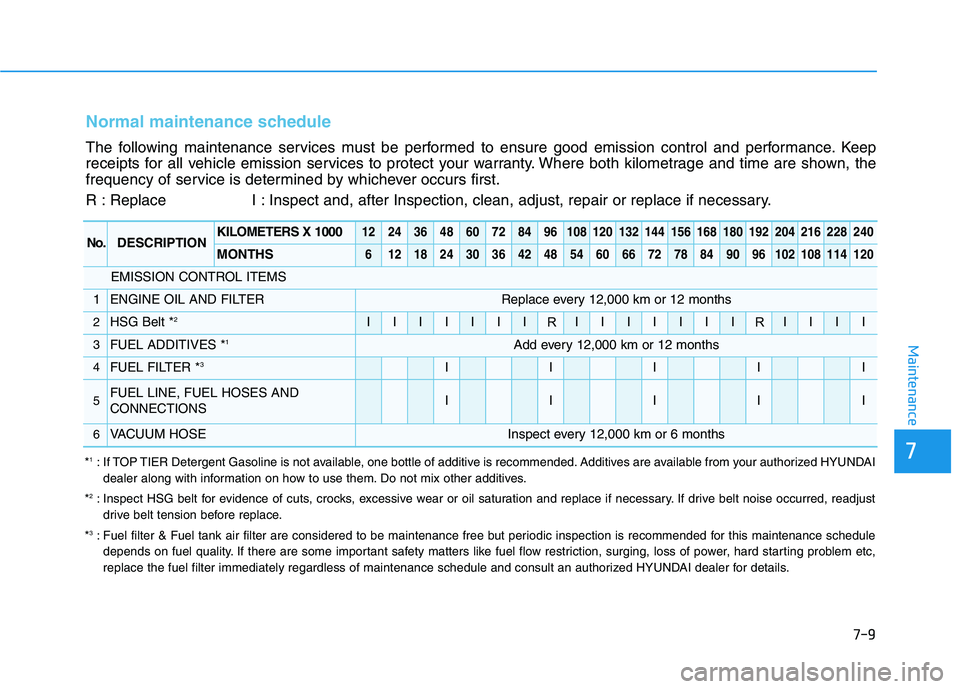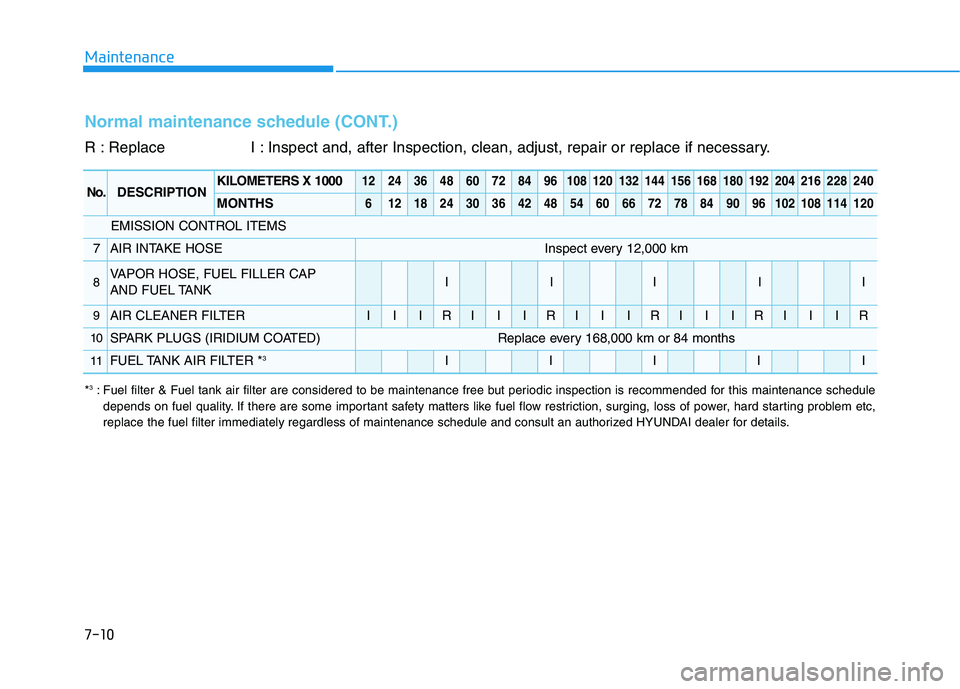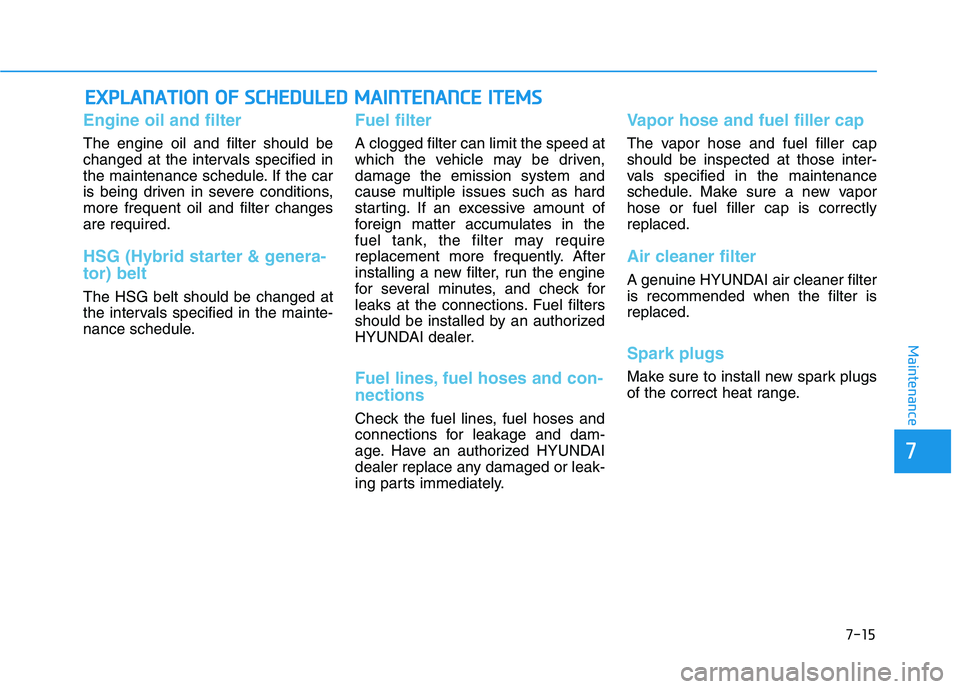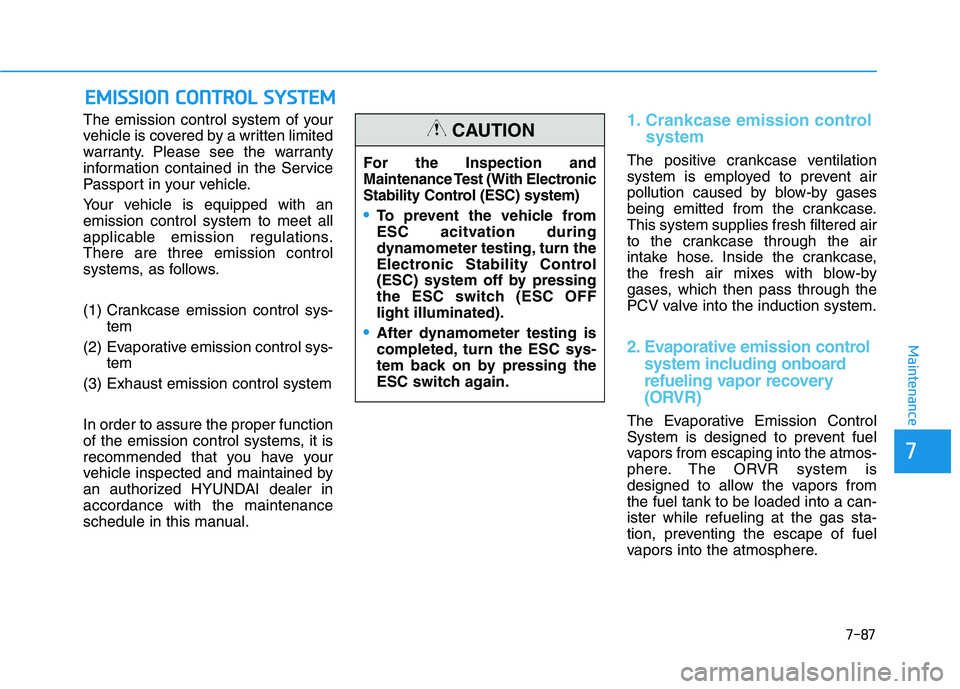2019 HYUNDAI SONATA HYBRID fuel filter
[x] Cancel search: fuel filterPage 447 of 546

7-9
7
Maintenance
Normal maintenance schedule
The following maintenance services must be performed to ensure good emission control and performance. Keep
receipts for all vehicle emission services to protect your warranty. Where both kilometrage and time are shown, the
frequency of service is determined by whichever occurs first.
R : Replace I : Inspect and, after Inspection, clean, adjust, repair or replace if necessary.
* 1
: If TOP TIER Detergent Gasoline is not available, one bottle of additive is recommended. Additives are available from your authorized HYUNDAI
dealer along with information on how to use them. Do not mix other additives.
* 2
: Inspect HSG belt for evidence of cuts, crocks, excessive wear or oil saturation and replace if necessary. If drive belt noise occurred, readjust
drive belt tension before replace.
* 3
: Fuel filter & Fuel tank air filter are considered to be maintenance free but periodic inspection is recommended for this maintenance schedule
depends on fuel quality. If there are some important safety matters like fuel flow restriction, surging, loss of power, hard starting problem etc,
replace the fuel filter immediately regardless of maintenance schedule and consult an authorized HYUNDAI dealer for details.
No.DESCRIPTIONKILOMETERS X 10001224364860728496108120132144156168180192204216228240
MONTHS6121824303642485460667278849096102108114120
EMISSION CONTROL ITEMS
1ENGINE OIL AND FILTERReplace every 12,000 km or 12 months
2HSG Belt * 2IIIIIIIRIIIIIIIRIIII
3FUEL ADDITIVES * 1Add every 12,000 km or 12 months
4FUEL FILTER *3IIIII
5FUEL LINE, FUEL HOSES AND CONNECTIONSIIIII
6VACUUM HOSEInspect every 12,000 km or 6 months
Page 448 of 546

7-10
Maintenance
Normal maintenance schedule (CONT.)
*3
: Fuel filter & Fuel tank air filter are considered to be maintenance free but periodic inspection is recommended for this maintenance schedule
depends on fuel quality. If there are some important safety matters like fuel flow restriction, surging, loss of power, hard starting problem etc,
replace the fuel filter immediately regardless of maintenance schedule and consult an authorized HYUNDAI dealer for details.
R : Replace I : Inspect and, after Inspection, clean, adjust, repair or replace if necessary.
No.DESCRIPTIONKILOMETERS X 10001224364860728496108120132144156168180192204216228240
MONTHS6121824303642485460667278849096102108114120
EMISSION CONTROL ITEMS
7AIR INTAKE HOSEInspect every 12,000 km
8VAPOR HOSE, FUEL FILLER CAP
AND FUEL TANKIIIII
9AIR CLEANER FILTERIIIRIIIRIIIRIIIRIIIR
10SPARK PLUGS (IRIDIUM COATED)Replace every 168,000 km or 84 months
11FUEL TANK AIR FILTER *
3IIIII
Page 453 of 546

7-15
7
Maintenance
EEXX PPLLAA NN AATTIIOO NN OO FF SS CC HH EEDD UU LLEE DD MM AAIINN TTEENN AANN CCEE IITT EEMM SS
Engine oil and filter
The engine oil and filter should be
changed at the intervals specified in
the maintenance schedule. If the car
is being driven in severe conditions,more frequent oil and filter changesare required.
HSG (Hybrid starter & genera- tor) belt
The HSG belt should be changed at
the intervals specified in the mainte-
nance schedule.
Fuel filter
A clogged filter can limit the speed at
which the vehicle may be driven,damage the emission system and
cause multiple issues such as hard
starting. If an excessive amount of
foreign matter accumulates in the
fuel tank, the filter may require
replacement more frequently. After
installing a new filter, run the engine
for several minutes, and check for
leaks at the connections. Fuel filters
should be installed by an authorized
HYUNDAI dealer.
Fuel lines, fuel hoses and con- nections
Check the fuel lines, fuel hoses and
connections for leakage and dam-
age. Have an authorized HYUNDAI
dealer replace any damaged or leak-
ing parts immediately.
Vapor hose and fuel filler cap
The vapor hose and fuel filler cap should be inspected at those inter-
vals specified in the maintenance
schedule. Make sure a new vaporhose or fuel filler cap is correctlyreplaced.
Air cleaner filter
A genuine HYUNDAI air cleaner filter is recommended when the filter isreplaced.
Spark plugs
Make sure to install new spark plugs
of the correct heat range.
Page 525 of 546

7-87
7
Maintenance
EEMM IISS SSIIOO NN CC OO NNTTRR OO LL SS YY SSTT EEMM
The emission control system of your
vehicle is covered by a written limited
warranty. Please see the warranty
information contained in the Service
Passport in your vehicle.
Your vehicle is equipped with an emission control system to meet all
applicable emission regulations.There are three emission control
systems, as follows.
(1) Crankcase emission control sys-
tem
(2) Evaporative emission control sys- tem
(3) Exhaust emission control systemIn order to assure the proper function
of the emission control systems, it is
recommended that you have your
vehicle inspected and maintained by
an authorized HYUNDAI dealer inaccordance with the maintenance
schedule in this manual.1. Crankcase emission control system
The positive crankcase ventilation
system is employed to prevent air
pollution caused by blow-by gases
being emitted from the crankcase.This system supplies fresh filtered air
to the crankcase through the air
intake hose. Inside the crankcase,
the fresh air mixes with blow-by
gases, which then pass through the
PCV valve into the induction system.
2. Evaporative emission controlsystem including onboard
refueling vapor recovery
(ORVR)
The Evaporative Emission Control
System is designed to prevent fuel
vapors from escaping into the atmos-
phere. The ORVR system is
designed to allow the vapors fromthe fuel tank to be loaded into a can-ister while refueling at the gas sta-
tion, preventing the escape of fuel
vapors into the atmosphere.
For the Inspection and
Maintenance Test (With Electronic
Stability Control (ESC) system)
To prevent the vehicle from
ESC acitvation during
dynamometer testing, turn the
Electronic Stability Control
(ESC) system off by pressing
the ESC switch (ESC OFFlight illuminated).
After dynamometer testing is
completed, turn the ESC sys-
tem back on by pressing the
ESC switch again.
CAUTION
Page 541 of 546

I-4
Driver Attention Alert system (DAA) ............................5-62
Resetting the system ...................................................5-64
System malfunction ....................................................5-64
System setting and activation .....................................5-62
System standby...........................................................5-64
Driver position memory system .....................................3-14 Easy Access Function .................................................3-15
Storing Positions into Memory ..................................3-14
Driving the Hybrid/Plug-in Hybrid Vehicle ....................H22
Changing plug-in hybrid mode ...................................H26
Energy flow.................................................................H38
Hybrid System Gauge .................................................H24
Special features ...........................................................H23
Starting the vehicle .....................................................H22
Warning and indicator lights.......................................H27
Warning messages.......................................................H28
Emission control system .................................................7-87 Crankcase emission control system ...........................7-87
Evaporative emission control system including onboard refueling vapor recovery (ORVR) ............7-87
Exhaust emission control system ...............................7-88
Engine ...............................................................................8-2
Engine compartment..................................................1-6, 7-3
Engine coolant/Inverter coolant ......................................7-20
Changing engine coolant ............................................7-23
Checking the engine/inverter coolant level................7-20 Engine number ..................................................................8-9
Engine oil ........................................................................7-18
Checking the engine oil and filter ..............................7-19
Checking the engine oil level .....................................7-18
Engine start/stop button ....................................................5-5
Engine Stop/Start button positions ...............................5-7
Illuminated Engine Start/Stop button ...........................5-6
Starting the hybrid system............................................5-9
Explanation of scheduled maintenance items.................7-15
Exterior features..............................................................3-39 Fuel Filler Door (Hybrid) ...........................................3-46
Fuel Filler Door (Plug-in hybrid) ...............................3-50
Hood ...........................................................................3-39
Smart Trunk ................................................................3-43
Trunk ..........................................................................3-40
Exterior overview (I) ........................................................1-2
Exterior overview (II) .......................................................1-3
Fuses ...............................................................................7-51 Engine compartment panel fuse replacement ............7-54
Fuse/relay panel description .......................................7-56
Instrument panel fuse replacement.............................7-52
Index
E
F